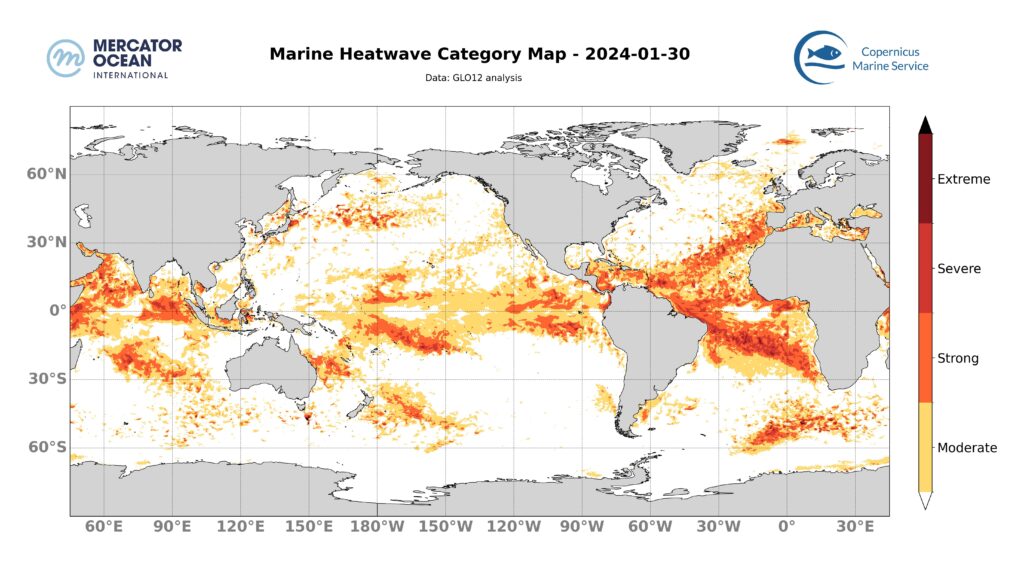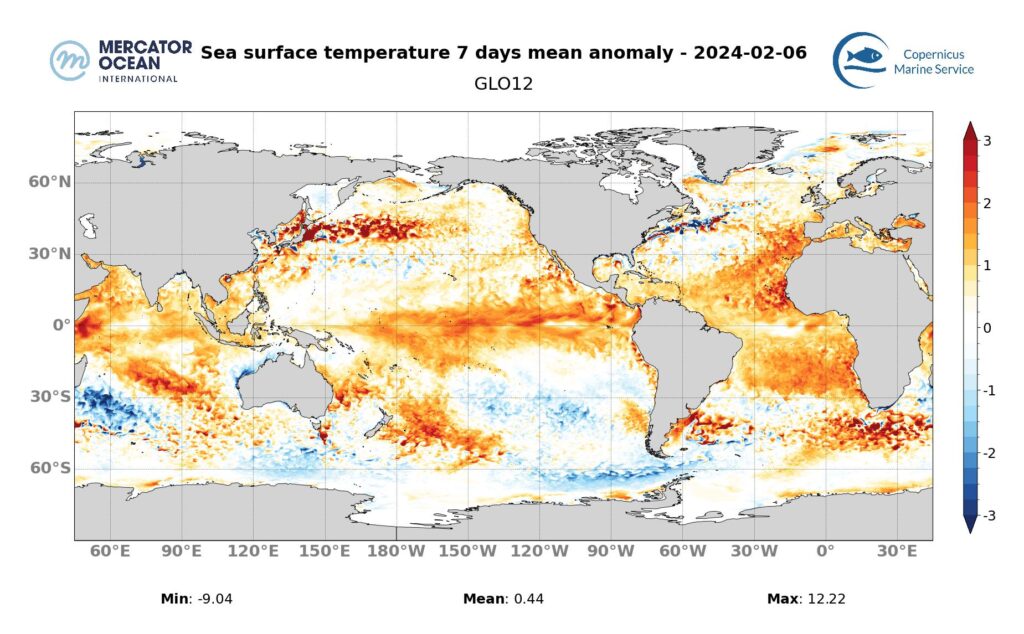Mercator Ocean International (MOi) oceanographers examine marine heatwaves across the global ocean. They analyse a variety of datasets from observations (satellite sea surface temperature maps) to numerical model analyses (assimilating satellite and in situ observations) and derive forecasts for a 7 day period.¹
Assessment for 30 January
Marine heatwave categories

North Atlantic Ocean (Europe zone)
- Marocco and Iberian Peninsula – increase surface area of strong categories
- Bay of Biscay – evolution to strong category
Mediterranean Sea
The situation remains stable over most of the basin, as well as in the eastern part, with moderate to locally severe marine heatwaves.
West of the basin – an increase in the extent of the moderate and strong categories.
North Tropical Atlantic Ocean
Marine heatwave present for several months but with strong categories decreasing in surface area.
South Tropical Atlantic Ocean
Brésil et la Namibie – marine heatwave is becoming slightly more intense, with an increase in the extent of the strong and severe categories along the trade winds.30°W and 30°E – marine heat wave with categories ranging from moderate to strong.
Tropical Pacific Ocean
The marine heat wave linked to the formation of an El Niño event in the region is generally stable to the East of the basin presenting categories between moderate and strong.
150 et 180°W – intensification of the marine heatwave reaching a strong category.
Coral Sea and Eastern Australia – The intensity of the heatwave is decreasing, with a reduction in the extent of the strong categories.
Pacifique Sud, à l’Est de Nouvelle Zélande la canicule marine présente en catégorie modérée s’intensifie, avec une plus grande étendue des catégories modérées ainsi que le développement de catégories fortes.
Indian Ocean
The marine heatwave present to the east of Madagascar remains stable.
Arabian Sea – the marine heatwave is intensifying, with a shift from moderate to severe categories along the coasts of Oman, Yemen and Somalia.
South of the Bay of Bengal – the marine heatwave is intensifying, changing from moderate to strong, and locally severe.
South East Asian Seas – the marine heatwave remains stable.
Weekly temperature anomalies
- North Atlantic (Europe zone) Ocean – 1.5 °C to 3°C
- Mediterranean Sea – 1.5 °C to 3°C
- North Tropical Atlantic Ocean – 1° C to 2.5° C
- South Tropical Atlantic Ocean– 1 °C to 2°C
- South Atlantic South – 1°C à 3°C.
- Tropical Pacific Ocean– 1.5°C to 3°C
- South Pacific Ocean – 1.5 °C 3°C
- Indian Ocean (west) – 1°C to 3°C
- South East Asian Seas – 1°C
Forecasts for 6 February

Europe zone
North Atlantic Ocean – the Mercator Ocean International (MOI) forecast system predicts a slight intensification of the marine heatwave along the coasts of Morocco and the Iberian Peninsula, as well as in the Bay of Biscay.
Mediterranean Sea – the forecast calls for an intensification in the western basin in general, with a larger surface area covered by strong categories, as well as in the eastern basin along the Turkish coast.
Global Ocean
North Tropical Atlantic – The marine heatwave remains stable.
Southern Tropical Atlantic – The marine heatwave between Namibia and the tip of Brazil continues to increase in intensity with the development of strong and severe categories on the way to the trade winds.
South Atlantic – between 30°W and 30°E, the marine heatwave remains stable.
Eastern Tropical Pacific – remains stable with mostly moderate and locally severe categories in the easternmost part of the basin.
Western Tropical Pacific – marine heatwaves are decreasing in intensity with a return to moderate category conditions.
Indian Ocean – in the Arabian Sea and the Bay of Bengal, marine heat waves remain stable.
What are marine heatwaves?
Marine heatwaves (MHW) are extreme rises in ocean temperature for an extended period of time. They can occur at different locations in the ocean, and their magnitude and frequency have increased over the last couple of decades, with harmful impacts on ecosystems, and human activities. According to the latest report released by the Intergovernmental Panel on Climate Change (IPCC AR6 SYR), it is found with high confidence that in the near-term at 1.5°C global warming, the increasing frequency of marine heatwaves will increase risks of biodiversity loss in the oceans, including from mass mortality events.2
How are marine heatwaves calculated?
A marine heatwave is a heat episode during which the temperature is significantly higher than a certain threshold for at least 5 consecutive days.

The seasonally-varying threshold is defined on a daily basis according to a sufficiently long climatic period (in this case 1993-2016). So, for a given place and a given day, knowing all the surface temperatures observed over the last 30 years, a heatwave situation is defined as one where the temperature measured is within 10% of the maximum values observed (i.e. above the 90th quantile, see diagram), for at least 5 consecutive days.
The main characteristics of heatwaves are their duration and intensity. The intensity for a given day corresponds to the value in degrees above the 90th quantile (blue arrow), which can either be calculated as the cumulative intensity throughout the heatwave event, or the maximum intensity.
Heatwaves are categorised on the basis of their deviation from the mean temperature or anomaly (green arrow): a deviation of more than 2 times the difference between the 90th quantile and the mean corresponds to a heatwave in the strong category; a deviation of more than 3 times corresponds to a heatwave in the severe category; and a deviation of more than 4 times corresponds to a heatwave in the extreme category.
¹Analysis of datasets: OSTIA sea surface temperature observations analysis (Copernicus Marine Service), OISST sea surface temperature observations analysis (NOAA), GLO12 model (Copernicus Marine Service, Mercator Ocean International)
² IPCC AR6 SYR 4.3 https://www.ipcc.ch/report/ar6/syr/downloads/report/IPCC_AR6_SYR_LongerReport.pdf
